Ruofan Wu
Helen
Are Large Language Models In-Context Graph Learners?
Feb 19, 2025Abstract:Large language models (LLMs) have demonstrated remarkable in-context reasoning capabilities across a wide range of tasks, particularly with unstructured inputs such as language or images. However, LLMs struggle to handle structured data, such as graphs, due to their lack of understanding of non-Euclidean structures. As a result, without additional fine-tuning, their performance significantly lags behind that of graph neural networks (GNNs) in graph learning tasks. In this paper, we show that learning on graph data can be conceptualized as a retrieval-augmented generation (RAG) process, where specific instances (e.g., nodes or edges) act as queries, and the graph itself serves as the retrieved context. Building on this insight, we propose a series of RAG frameworks to enhance the in-context learning capabilities of LLMs for graph learning tasks. Comprehensive evaluations demonstrate that our proposed RAG frameworks significantly improve LLM performance on graph-based tasks, particularly in scenarios where a pretrained LLM must be used without modification or accessed via an API.
Revisiting and Benchmarking Graph Autoencoders: A Contrastive Learning Perspective
Oct 14, 2024



Abstract:Graph autoencoders (GAEs) are self-supervised learning models that can learn meaningful representations of graph-structured data by reconstructing the input graph from a low-dimensional latent space. Over the past few years, GAEs have gained significant attention in academia and industry. In particular, the recent advent of GAEs with masked autoencoding schemes marks a significant advancement in graph self-supervised learning research. While numerous GAEs have been proposed, the underlying mechanisms of GAEs are not well understood, and a comprehensive benchmark for GAEs is still lacking. In this work, we bridge the gap between GAEs and contrastive learning by establishing conceptual and methodological connections. We revisit the GAEs studied in previous works and demonstrate how contrastive learning principles can be applied to GAEs. Motivated by these insights, we introduce lrGAE (left-right GAE), a general and powerful GAE framework that leverages contrastive learning principles to learn meaningful representations. Our proposed lrGAE not only facilitates a deeper understanding of GAEs but also sets a new benchmark for GAEs across diverse graph-based learning tasks. The source code for lrGAE, including the baselines and all the code for reproducing the results, is publicly available at https://github.com/EdisonLeeeee/lrGAE.
Ultra-imbalanced classification guided by statistical information
Sep 06, 2024Abstract:Imbalanced data are frequently encountered in real-world classification tasks. Previous works on imbalanced learning mostly focused on learning with a minority class of few samples. However, the notion of imbalance also applies to cases where the minority class contains abundant samples, which is usually the case for industrial applications like fraud detection in the area of financial risk management. In this paper, we take a population-level approach to imbalanced learning by proposing a new formulation called \emph{ultra-imbalanced classification} (UIC). Under UIC, loss functions behave differently even if infinite amount of training samples are available. To understand the intrinsic difficulty of UIC problems, we borrow ideas from information theory and establish a framework to compare different loss functions through the lens of statistical information. A novel learning objective termed Tunable Boosting Loss is developed which is provably resistant against data imbalance under UIC, as well as being empirically efficient verified by extensive experimental studies on both public and industrial datasets.
Revisiting Modularity Maximization for Graph Clustering: A Contrastive Learning Perspective
Jun 20, 2024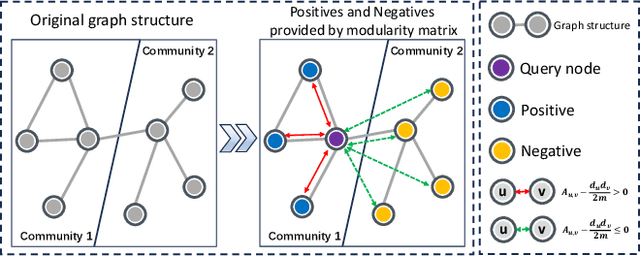
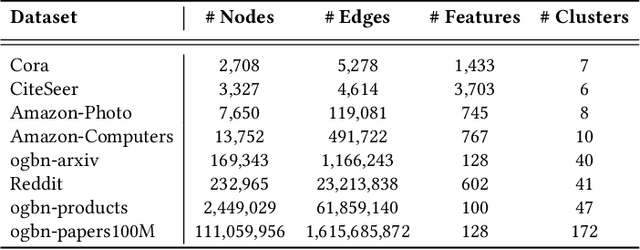

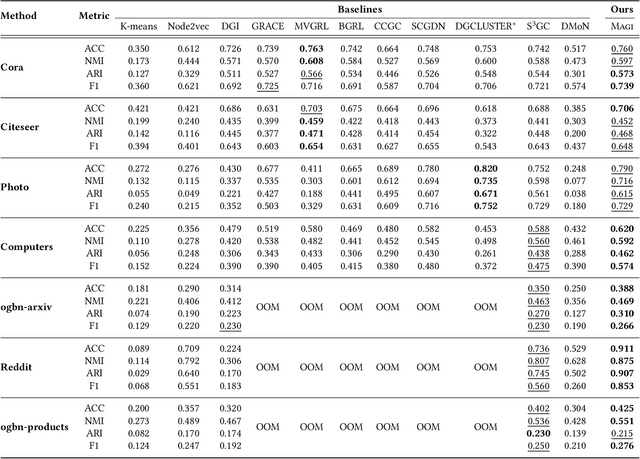
Abstract:Graph clustering, a fundamental and challenging task in graph mining, aims to classify nodes in a graph into several disjoint clusters. In recent years, graph contrastive learning (GCL) has emerged as a dominant line of research in graph clustering and advances the new state-of-the-art. However, GCL-based methods heavily rely on graph augmentations and contrastive schemes, which may potentially introduce challenges such as semantic drift and scalability issues. Another promising line of research involves the adoption of modularity maximization, a popular and effective measure for community detection, as the guiding principle for clustering tasks. Despite the recent progress, the underlying mechanism of modularity maximization is still not well understood. In this work, we dig into the hidden success of modularity maximization for graph clustering. Our analysis reveals the strong connections between modularity maximization and graph contrastive learning, where positive and negative examples are naturally defined by modularity. In light of our results, we propose a community-aware graph clustering framework, coined MAGI, which leverages modularity maximization as a contrastive pretext task to effectively uncover the underlying information of communities in graphs, while avoiding the problem of semantic drift. Extensive experiments on multiple graph datasets verify the effectiveness of MAGI in terms of scalability and clustering performance compared to state-of-the-art graph clustering methods. Notably, MAGI easily scales a sufficiently large graph with 100M nodes while outperforming strong baselines.
State Space Models on Temporal Graphs: A First-Principles Study
Jun 03, 2024Abstract:Over the past few years, research on deep graph learning has shifted from static graphs to temporal graphs in response to real-world complex systems that exhibit dynamic behaviors. In practice, temporal graphs are formalized as an ordered sequence of static graph snapshots observed at discrete time points. Sequence models such as RNNs or Transformers have long been the predominant backbone networks for modeling such temporal graphs. Yet, despite the promising results, RNNs struggle with long-range dependencies, while transformers are burdened by quadratic computational complexity. Recently, state space models (SSMs), which are framed as discretized representations of an underlying continuous-time linear dynamical system, have garnered substantial attention and achieved breakthrough advancements in independent sequence modeling. In this work, we undertake a principled investigation that extends SSM theory to temporal graphs by integrating structural information into the online approximation objective via the adoption of a Laplacian regularization term. The emergent continuous-time system introduces novel algorithmic challenges, thereby necessitating our development of GraphSSM, a graph state space model for modeling the dynamics of temporal graphs. Extensive experimental results demonstrate the effectiveness of our GraphSSM framework across various temporal graph benchmarks.
On provable privacy vulnerabilities of graph representations
Feb 06, 2024Abstract:Graph representation learning (GRL) is critical for extracting insights from complex network structures, but it also raises security concerns due to potential privacy vulnerabilities in these representations. This paper investigates the structural vulnerabilities in graph neural models where sensitive topological information can be inferred through edge reconstruction attacks. Our research primarily addresses the theoretical underpinnings of cosine-similarity-based edge reconstruction attacks (COSERA), providing theoretical and empirical evidence that such attacks can perfectly reconstruct sparse Erdos Renyi graphs with independent random features as graph size increases. Conversely, we establish that sparsity is a critical factor for COSERA's effectiveness, as demonstrated through analysis and experiments on stochastic block models. Finally, we explore the resilience of (provably) private graph representations produced via noisy aggregation (NAG) mechanism against COSERA. We empirically delineate instances wherein COSERA demonstrates both efficacy and deficiency in its capacity to function as an instrument for elucidating the trade-off between privacy and utility.
LasTGL: An Industrial Framework for Large-Scale Temporal Graph Learning
Nov 30, 2023



Abstract:Over the past few years, graph neural networks (GNNs) have become powerful and practical tools for learning on (static) graph-structure data. However, many real-world applications, such as social networks and e-commerce, involve temporal graphs where nodes and edges are dynamically evolving. Temporal graph neural networks (TGNNs) have progressively emerged as an extension of GNNs to address time-evolving graphs and have gradually become a trending research topic in both academics and industry. Advancing research and application in such an emerging field necessitates the development of new tools to compose TGNN models and unify their different schemes for dealing with temporal graphs. In this work, we introduce LasTGL, an industrial framework that integrates unified and extensible implementations of common temporal graph learning algorithms for various advanced tasks. The purpose of LasTGL is to provide the essential building blocks for solving temporal graph learning tasks, focusing on the guiding principles of user-friendliness and quick prototyping on which PyTorch is based. In particular, LasTGL provides comprehensive temporal graph datasets, TGNN models and utilities along with well-documented tutorials, making it suitable for both absolute beginners and expert deep learning practitioners alike.
Mitigating Estimation Errors by Twin TD-Regularized Actor and Critic for Deep Reinforcement Learning
Nov 07, 2023Abstract:We address the issue of estimation bias in deep reinforcement learning (DRL) by introducing solution mechanisms that include a new, twin TD-regularized actor-critic (TDR) method. It aims at reducing both over and under-estimation errors. With TDR and by combining good DRL improvements, such as distributional learning and long N-step surrogate stage reward (LNSS) method, we show that our new TDR-based actor-critic learning has enabled DRL methods to outperform their respective baselines in challenging environments in DeepMind Control Suite. Furthermore, they elevate TD3 and SAC respectively to a level of performance comparable to that of D4PG (the current SOTA), and they also improve the performance of D4PG to a new SOTA level measured by mean reward, convergence speed, learning success rate, and learning variance.
Privacy-preserving design of graph neural networks with applications to vertical federated learning
Oct 31, 2023



Abstract:The paradigm of vertical federated learning (VFL), where institutions collaboratively train machine learning models via combining each other's local feature or label information, has achieved great success in applications to financial risk management (FRM). The surging developments of graph representation learning (GRL) have opened up new opportunities for FRM applications under FL via efficiently utilizing the graph-structured data generated from underlying transaction networks. Meanwhile, transaction information is often considered highly sensitive. To prevent data leakage during training, it is critical to develop FL protocols with formal privacy guarantees. In this paper, we present an end-to-end GRL framework in the VFL setting called VESPER, which is built upon a general privatization scheme termed perturbed message passing (PMP) that allows the privatization of many popular graph neural architectures.Based on PMP, we discuss the strengths and weaknesses of specific design choices of concrete graph neural architectures and provide solutions and improvements for both dense and sparse graphs. Extensive empirical evaluations over both public datasets and an industry dataset demonstrate that VESPER is capable of training high-performance GNN models over both sparse and dense graphs under reasonable privacy budgets.
Hetero$^2$Net: Heterophily-aware Representation Learning on Heterogenerous Graphs
Oct 18, 2023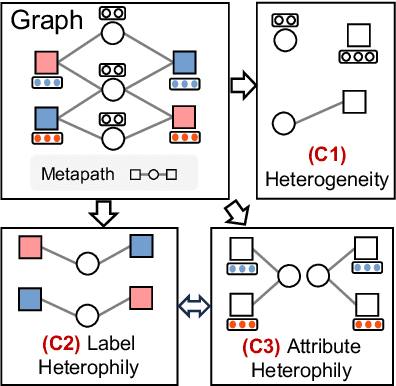
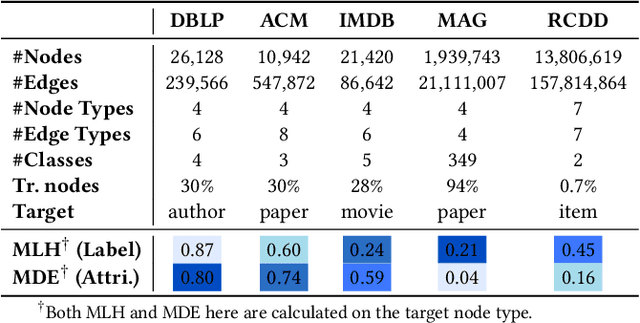
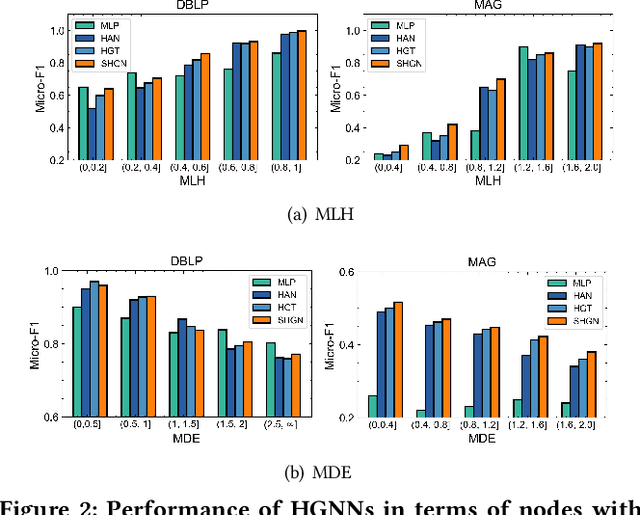
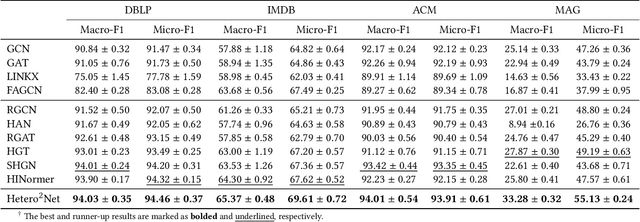
Abstract:Real-world graphs are typically complex, exhibiting heterogeneity in the global structure, as well as strong heterophily within local neighborhoods. While a growing body of literature has revealed the limitations of common graph neural networks (GNNs) in handling homogeneous graphs with heterophily, little work has been conducted on investigating the heterophily properties in the context of heterogeneous graphs. To bridge this research gap, we identify the heterophily in heterogeneous graphs using metapaths and propose two practical metrics to quantitatively describe the levels of heterophily. Through in-depth investigations on several real-world heterogeneous graphs exhibiting varying levels of heterophily, we have observed that heterogeneous graph neural networks (HGNNs), which inherit many mechanisms from GNNs designed for homogeneous graphs, fail to generalize to heterogeneous graphs with heterophily or low level of homophily. To address the challenge, we present Hetero$^2$Net, a heterophily-aware HGNN that incorporates both masked metapath prediction and masked label prediction tasks to effectively and flexibly handle both homophilic and heterophilic heterogeneous graphs. We evaluate the performance of Hetero$^2$Net on five real-world heterogeneous graph benchmarks with varying levels of heterophily. The results demonstrate that Hetero$^2$Net outperforms strong baselines in the semi-supervised node classification task, providing valuable insights into effectively handling more complex heterogeneous graphs.
 Add to Chrome
Add to Chrome Add to Firefox
Add to Firefox Add to Edge
Add to Edge